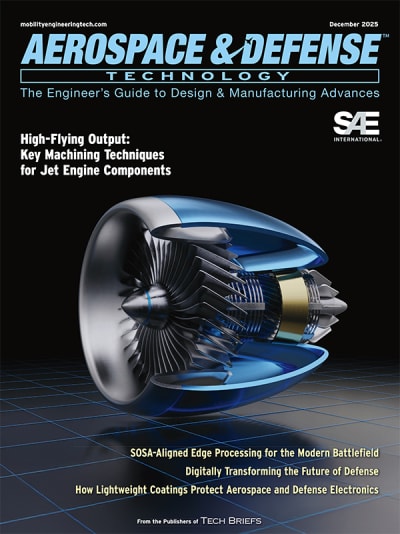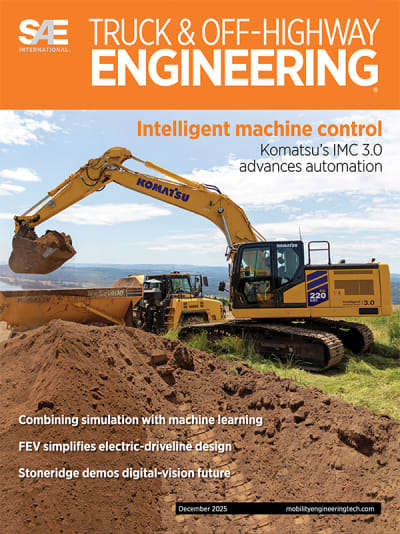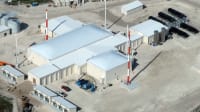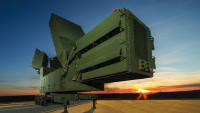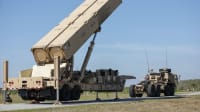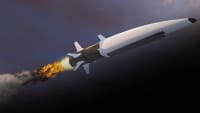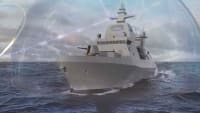Can Embedded Electronics Components Meet the Demands of Hypersonic Missiles?

Today, defense organizations in several countries are attempting to expand military capabilities by investing in hypersonic missile development. Since these missiles travel at Mach 5, or nearly 4,000 mph, there are naturally a variety of challenges for developing both the actual weapons systems and the corresponding detection systems. While challenges span nearly every aspect of developing these missiles, in this article we will focus specifically on the key challenges associated with the embedded electronics and communication systems. We will also look at how aerospace and defense engineers working on hypersonic missiles can ensure they are selecting supplier partners that are well positioned to meet these unique challenges by looking into their space heritage and history developing high-reliability radiofrequency (RF) components.
Examining the Challenges of Developing Missiles Traveling at Mach 5

As shown in Table 1, many military aircraft and weaponry today are capable of traveling at supersonic speeds. But as the industry continues to work on more sophisticated means for conducting military missions — including weaponry that can reach intended targets quicker with even greater accuracy while remaining virtually undetectable — aerospace and defense companies are pushing missile speed boundaries. As a result, missiles are now entering hypersonic speed territory.
When traveling at speeds of nearly 4,000 mph, or about a mile per second, engineers are facing a whole host of new challenges for developing both the embedded electronics on the missiles and the detection systems required to track enemy weaponry. First, all the components used inside a missile traveling at Mach 5 will face unprecedentedly harsh environmental conditions. This includes intense shock and vibration from uncontrolled energies at resonant frequencies, temperatures pushing beyond 2,000 °F because of friction, and intense pressure from the extreme G forces experienced during acceleration. In addition to these harsh conditions, like most embedded electronic systems, hypersonic missiles need everything used inside to be smaller and lighter, therefore, miniaturized high-reliability capacitors and filters are a must.
Second, because hypersonic missiles such as the boost-glide missiles are intended to also be highly maneuverable at these high speeds, the missile must maintain uninterrupted and precise communications with the control base station. This means the communication system must be capable of performing near real-time mission computing that can adjust to changing conditions while ensuring all subsystems continue to work together to accomplish the mission — even if that mission is changing.

Third, since multiple countries are currently investing in hypersonic missile development, hypersonic weapons detection systems using high selectivity and low loss RF filters are also necessary. Since hypersonic missiles have a completely different flight path than other missile types — these missiles exploit the curvature of the Earth to avoid ground-based radar tracking yet travel low enough to be missed by infrared tracking as shown in Figure 1 — new detection satellites must be developed as well.
Selecting Suppliers for the Evolving Challenges of Hypersonic Missile Development

When any technology aims to push the boundaries of what’s possible, the suppliers capable of developing the required components must accelerate innovation at the component level as well. But, when working on an application that pushes limits, it can be hard to determine which suppliers can push the limits with you. Oftentimes, companies will find themselves looking into new suppliers and evaluating the associated risks. But take the current shift in automobile industry innovations from combustion energy to electrification as an example. For many automobile manufacturers, as they experiment with battery technologies that can extend range and accelerate charging times, they have found that the suppliers who have reliably met their needs for decades are also readily available to develop the components needed for their electric vehicles as well.

Similarly, for the aerospace and defense industry, suppliers with long-established space heritage are also in the best position to develop components that can meet the new challenges associated with hypersonic missile weaponry and detection system development. This is because companies who have supplied high-performance electrical and RF components to the aerospace and defense industry for decades are familiar with the industry’s unique needs such as elevated reliability requirements and industry-specific testing for these mission-critical devices. Furthermore, specialty components manufacturers who are capable of taking on the complex challenges that come with high-reliability, high-temperature, high-performance, and high-frequency solutions, are even more ready to meet these challenges.
For example, Knowles Precision Devices, who makes a wide variety of specialty electrical and RF components, has supplied a range of commercial-off-the-shelf (COTS) and custom parts for applications operating in harsh environments such as space for more than 25 years. This experience includes providing components for electronic subassemblies that operate below the Earth’s surface at temperatures exceeding 230 °C to supplying high-performance, high-reliability RF filter assemblies for numerous Mars missions including the Spirit, Opportunity, Curiosity, and Perseverance. More specifically, this has included supplying components for re-entry vehicles that must survive as the lander makes its way to the planet’s surface.
Knowles Precision Devices has also supplied a wide range of high-reliability filtering options for satellite communications products from the C-band to the Ka-band. Plus, beyond the decades of experience Knowles Precision Devices has helping power electronic components for numerous space missions, its parent company, Knowles Corp., is well-versed in supplying tiny, high-reliability microphones for space missions as well. For example, they’ve supplied microphones that were housed within the Mars Rover’s SuperCam, capturing the first recorded sound of Martian wind and rocks being struck by lasers, as well as the historic flight of the Ingenuity Mars Helicopter.
Currently, in the U.S., the Pentagon can detect the launch of a hypersonic missile, but it will then be out of view until late in the missile’s flight path, which means there would be very little, if any, time left for a counterstrike. That has forced the Pentagon to prioritize investments in advanced missile capabilities, such as hypersonic technologies and directed energy weapon systems as a key facet of its ongoing modernization effort.
According to a December 2022 announcement, the Office of the Undersecretary of Defense for Acquisition and Sustainment is making targeted investments aimed at mitigating supply chain vulnerabilities, ranging from raw materials and chemical shortages to critical subcomponent suppliers.
Furthermore, the office has established the new Industrial Base Analysis and Sustainment Program, and the Defense Production Act Title III Program, to ensure the timely availability of essential domestic industrial resources to support national defense and homeland security requirements. “The IBAS and Title III programs plan to invest more than $200 million into the hypersonic industrial base to de-risk supply chains and increase throughput of critical components for the Navy’s and Army’s hypersonic programs,” according to the announcement.
As the U.S. military and its international allies continue to establish such investments that will tackle many of the electrical and communication challenges that need to be overcome to push the boundaries of missile technology to Mach 5 speeds, suppliers with long-established space heritage remain best positioned to develop components to meet evolving challenges.
This article was written by Peter Matthews, Senior Technical Marketing Manager, Knowles Precision Devices. For more information, visit here .
Top Stories
INSIDERLighting Technology
![]() Using Ultrabright X-Rays to Test Materials for Ultrafast Aircraft
Using Ultrabright X-Rays to Test Materials for Ultrafast Aircraft
INSIDERDesign
![]() New 3D-Printable Nanocomposite Prevents Overheating in Military Electronics
New 3D-Printable Nanocomposite Prevents Overheating in Military Electronics
INSIDERUnmanned Systems
![]() F-22 Pilot Controls Drone With Tablet
F-22 Pilot Controls Drone With Tablet
INSIDERDesign
![]() F-35 Proves Nuke Drop Performance in Stockpile Flight Testing
F-35 Proves Nuke Drop Performance in Stockpile Flight Testing
INSIDERAR/AI
![]() Algorithms for Autonomous Marine Vehicles
Algorithms for Autonomous Marine Vehicles
INSIDERTest & Measurement
![]() NASA’s Quiet Supersonic Demonstrator Jet Completes First Flight
NASA’s Quiet Supersonic Demonstrator Jet Completes First Flight
Webcasts
Energy
![]() SAE Automotive Engineering Podcast: Additive Manufacturing
SAE Automotive Engineering Podcast: Additive Manufacturing
Aerospace
![]() A New Approach to Manufacturing Machine Connectivity for the Air Force
A New Approach to Manufacturing Machine Connectivity for the Air Force
Automotive
![]() Optimizing Production Processes with the Virtual Twin
Optimizing Production Processes with the Virtual Twin
Energy
![]() EV and Battery Thermal Management Strategies
EV and Battery Thermal Management Strategies
Energy
![]() How Packet Digital Is Scaling Domestic Drone Battery Manufacturing
How Packet Digital Is Scaling Domestic Drone Battery Manufacturing
Automotive
![]() Advancements in Zinc Die Casting Technology & Alloys for Next-Generation...
Advancements in Zinc Die Casting Technology & Alloys for Next-Generation...

